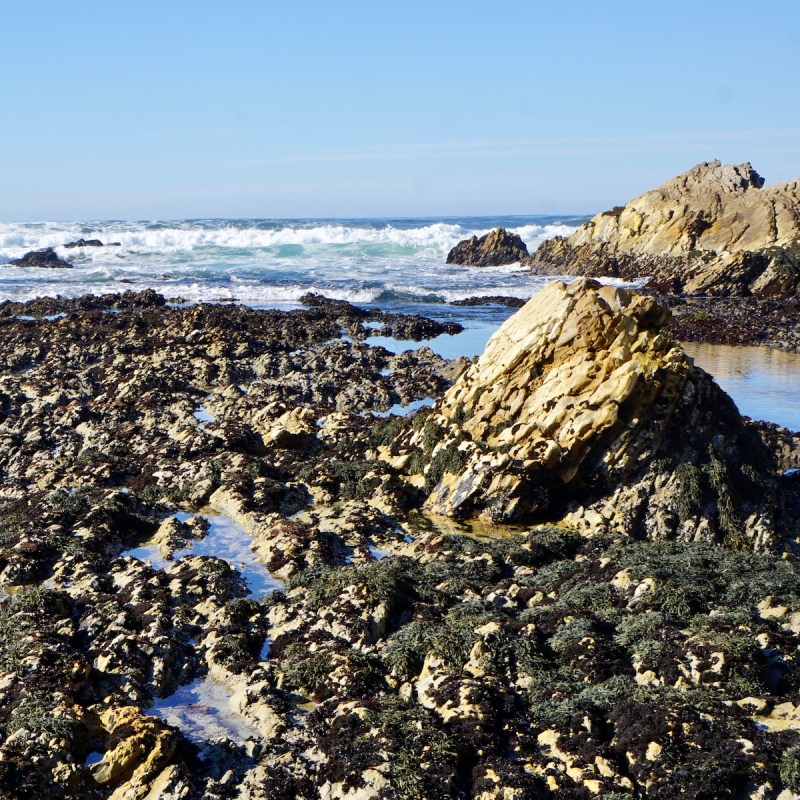
The lofty cliffs that border the cobalt-blue waters of the Pacific Ocean will likely be the first feature you notice upon arrival at the stunning Montaña de Oro State Park located along California’s Central Coast.
Videos by TravelAwaits
And certainly, with its vantage point near the iconic Pacific Coast Highway 1, the park’s oceanfront viewpoints are a sight to see and are reason enough to visit.
But visitors will soon discover that Montaña de Oro State Park — located about 10 miles south of the pretty town of Morro Bay and about 16 miles west of San Luis Obispo — has layers that go deeper than the sweeping ocean views.
On my recent visit, I was also delighted by the centuries-old history of the people who came before; the pretty, sandy Spooner’s Cove that is perfect for wading and kayaking; and the sea birds that soar over the water before resting on rocky bluffs.
Add in an endless array of outdoor activities, plentiful wildlife sightings, and gorgeous wildflowers, and you have the makings of a visit that offers something for virtually everyone.
Here are seven of the best experiences at Montaña de Oro State Park.

1. Explore The History At Spooner Ranch House
Like many of the early ranches in the state and national parks of the United States, the rolling hills, bluffs, and dunes that became known as the Montaña de Oro have a fascinating story to tell.
Although the modern ranch history dates back to the late 1800s with the arrival of the Spooner family, the human history on the land goes back much further. When Spanish explorers arrived in the area more than 5 centuries ago, the area was made up of a series of small villages of the Chumash and Salinan people, whose livelihoods came largely from the sea.
A brochure at the park notes that Montaña de Oro is part of the Pecho coast, the Spanish name for the section of California coastline between Avila Beach and Los Osos. The land “has been associated with the history of many people,” it says, noting that the Spooner family’s presence is part of a much larger story of 10,000 years of human occupation of the Pecho Coast.
In 1892, Alden Bradford Spooner II leased a remote section of coastline south of Morro Bay and began developing a ranch that ultimately grew to 9,000 acres and spanned three generations of Spooners. Alden and his brother Cornelius started by building a three-room house on a bluff overlooking what is now known as the park’s Spooner’s Cove. He then moved his wife Mary and three sons from Morro Bay and started the Pecho ranch.
The family home was enlarged over the years and now serves as the visitor center for the Montaña de Oro State Park. Today, visitors can wander through the rooms, with their vintage furnishings, and take in the stellar views of the coastline that the Spooners once enjoyed from their living-room and bedroom windows.
Displays also offer information about the Spooners’ ingenuity in running a productive dairy and cattle ranch in the remote locale — at one point digging a sloping chute through the shale bluff to a trestle, where sacks of beans and grain and bales of hay were loaded onto anchored schooners — as well as the ranch’s prominent role in the Prohibition era, a time during the 1920s and early 1930s when the production, sale, and transportation of alcoholic beverages were constitutionally prohibited.

2. Kayak Or Wade In Spooner’s Cove
Made up of about 8,000 acres and 7 miles of coastline, Montaña de Oro State Park has plenty of opportunities to experience the ocean. For a close-up taste, head to Spooner’s Cove, the park’s signature beach.
The cove is located where Islay Creek empties into the Pacific Ocean, and the sandy beach is bordered by steep cliffs and unique rock formations. You’ll find family groups picnicking on the beach, kayakers launching from the shore, and kids wading into the waves. The area is especially good for exploring during lower tides.
Not far from the beach is the Visitor Center for Montaña de Oro State Park, as well as the Islay Creek Campground. Spooner’s Cove beach has a parking area with plenty of spaces, picnic tables, and restrooms. The beach is dog-friendly as long as they are on a leash.
Pro Tip: Kayak rentals are available in nearby Morro Bay at numerous spots including A Kayak Shack.

3. Take In Ocean Views On The Bluff Trail
For a chance to enjoy the views from the bluffs, as well as from the sandy beaches, Montaña de Oro’s Bluff Trail is hard to beat. It is a 3.4-mile out-and-back trail that follows the coastline. It also features areas with tidepools, whale watching overlooks, and bridges over washes in the rolling hills.
Expect to take about an hour and 30 minutes walking the Bluff Trail, which has a mostly gentle grade and is rated as easy.
Other hikes worth checking out include the nearby 4.4-mile Valencia Peak Trail, an out-and-back trail that includes a 1,256-foot elevation gain and is rated as intermediate and is estimated to take about 2 hours and 40 minutes; and the Hazard Peak Trail, an 11.2-mile intermediate out-and-back hike that includes a nearly 1,000-foot elevation gain and takes about 6 hours to complete.

4. Explore The Tidepools
Low tide at Corallina Cove located just off the Bluff Trail exposes an area of rocky reefs that support a rich and diverse sea life — from black abalone to ochre sea stars to sea mussels to lined shore crab.
A sign at the entrance to the spur trail that heads to the tidepools of Corallina Cove cautions walkers to tread lightly in the area to protect the diverse sea life. Even without venturing into the tidepools, you can get a good sense of the environment by sanding on the pebbly shore and gazing into the spiky reef. Great views of the tidepool area are also visible along the somewhat steep trail heading to the beach.

5. Ride Horseback On The Bluffs
True to its ranching past, Montaña de Oro is a popular spot for horseback riding, and the park’s main campground, Islay Creek, offers three horse campsites and two group horse campsites for people who want to bring their own horses. Both provide water for horses, as well as limited stables for the group sites.
The hiking and biking trails that run along the coastline and into the mountains at Montaña de Oro are also designated as equestrian trails, so horseback riders have plenty of riding opportunities. On my recent visit to Montaña de Oro, I spotted numerous riders taking in the ocean views on the seaside bluffs.
Pro Tip: Along with the opportunities for bringing your own horses to Montaña de Oro, the California Highway 1 Roadtrip website lists a number of horseback riding opportunities located nearby. Highway 1 Roadtrip

6. Savor The Golden Wildflowers
Montaña de Oro derives its name — “Mountains of Gold” – from the golden poppies that often blanket the hills of the region in the springtime.
When I visited in December, I wasn’t overly hopeful about taking in Montaña de Oro’s namesake golden poppies, so it was with much enjoyment that I noticed that, even in the winter, a few sprigs of wildflowers could be spotted along the Bluff Trail.
I also noticed a number of other shrubs and bushes along the way that sported yellow and purple flowers. Along with the signature poppies, Montaña de Oro is known to have brittlebush, bluebells, lupine, sand verbena, and evening primrose.
Pro Tip: For a full range of wildflowers, March and April are the best months to visit Montaña de Oro. More information about California wildflowers can be found on the California Department of Fish and Wildlife website here.

7. Enjoy Wildlife Sightings
Signs of life are everywhere in Montaña de Oro, from black oystercatchers swooping toward the ocean, to the “Whale Trail” information that is available along the Bluff Trail, to the deer and ground squirrels that can be spotted along the way.
On my visit, I saw a number of deer and squirrels, as well as a range of birds perched on the cliffs overlooking the ocean. Although I did not spot any whales in the ocean, signs along the way note that Montaña de Oro is a part of the Whale Trail and offers one of the best locations on the Central Coast for wildlife viewing.
“From here, you can see otters, seabirds, seals, and dolphins,” said a sign along the Bluff Trail, adding: “Watch whales year round, with best viewing opportunities from mid-December through early April.”

Pro Tip
The temperate climate of California’s Central Coast makes the area a year-round destination. Montaña de Oro State Park posts average high temperatures in the 60-degree Fahrenheit range all year long, except for in October when the average high is 70 degrees. Average lows hover in the 40s and 50s all year, with January, February, March, and April all posting average lows in the mid-40s, and highs in the mid-60s. January and February are the rainiest months, with an average of 7 days of rain, while June through September post averages of zero days of rain.
California has a number of parks ready for outdoor adventures:
